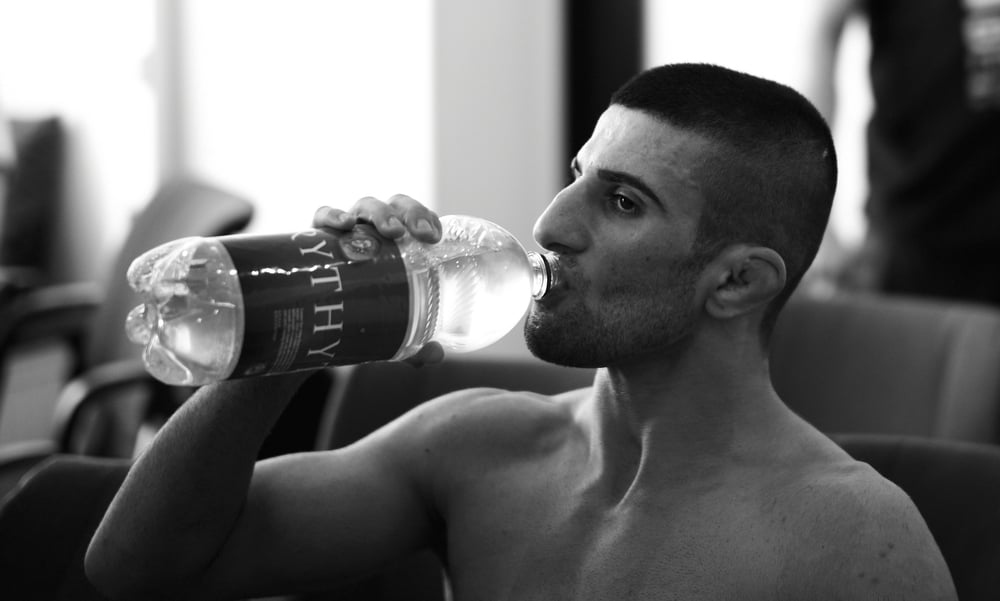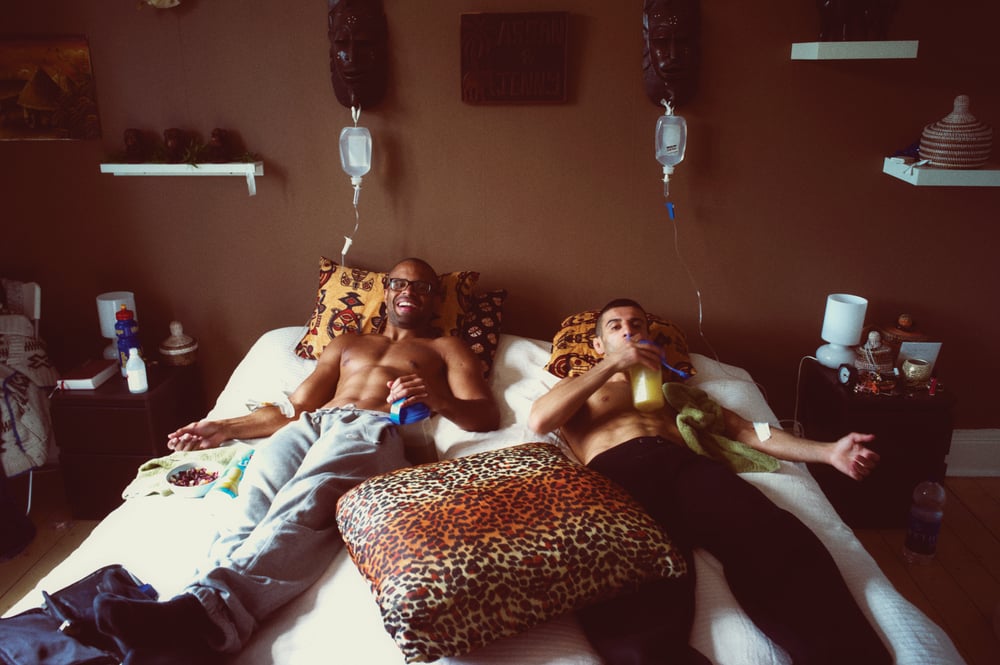
Issue 120
October 2014
Tips from the top on how to safely rehydrate and refuel after making weight
So, you’ve made weight. The needle of the scales was bang on the contracted fight limit and all the painful hours of toil to enable water shedding have come to a anticlimactic yet successful conclusion at the official weigh-in. That’s the most critical and significant 24 hours of your fight camp over with now then, right?
Wrong, actually. While the challenge of making weight may now safely be behind you, the far more important task of rehydrating and revitalizing your body post scale next could be detrimental to your chances of success inside the ring or cage.
“You should look at the weight cut as a chance to purify the system, to detoxify it of any impurities and fill it back up with the highest quality of nutrients at the most crucial time,” says Mike Dolce, the winner of last year’s Fighters Only World MMA Awards ‘Trainer of the Year’ and nutrition advisor to a catalogue of the UFC’s brightest and biggest stars.
That means sticking to your diet after you step off the scales too. After all, if you’ve done your cut right, you’ve lived on healthy nutrition for the past few weeks so it would be inimical to start gorging on fatty foods at the 11th hour.
THE WORST WAY TO FINISH A CUT
And yet so many fighters do. The temptation to ‘reward’ themselves after making weight with a meal they’re craving rather than what the body requires can not only bring on illness and further suffering, but also ultimately eradicate all the hard work that’s gone in the previous two months.
“It is not what we consume but what we absorb that matters,” adds Dolce. “Most often, when an athlete steps off the scale, he is in a state of dehydration. The body is primarily made up of water and so it needs to establish a favorable balance of water before our systems will begin functioning normally, especially the digestive system.”
So there is absolutely no point ploughing into chicken pasta or even guzzling protein shakes, as all you will do is put the body into shock. Which means it will likely look to evacuate the new food sources the quickest way possible. That means belly aches, vomiting and diarrhoea.
Dolce adds: “Our emotional side is what craves the food, but if an athlete walked into a hospital in the same dehydrated state the doctors would immediately act to replenish the fluids and electrolytes and not hand them a plate of pasta.”
RAPID REHYDRATION
A growing number of fighters, following a trend with endurance athletes like multi-stage cyclists and ironman competitors, have taken the point Dolce makes literally in treating their weigh-in dehydration like you would a medical emergency.
Intravenous therapy, known simply as IVs, put fluids and minerals directly back into the bloodstream via a drip. Standard IVs provide saline (water and sodium) and sometimes a low concentration of glucose. They are used to correct fluid, electrolyte and carbohydrate deficits in people who are unable to do this by eating and drinking, but are being used increasingly across sports.
Top-ranked British UFC flyweight Brad Pickett, who began his career as a lightweight, regularly does IVs and insists it’s a fast-track to replenish after a tough cut. “If you cut a lot of water weight, and lose a lot of minerals and stuff, then an IV can really help,” he says.
“I get it done by a medical professional, of course, so there is no risk involved. The reason I do that is because it’s a faster way to replenish the body of the good stuff you lose when cutting water.”
He adds: “Say you were lost in a desert, and you were fully dehydrated. When you arrived at the hospital the first thing they would do is put you on an IV. They don’t give you a gallon of water and a bowl of pasta. They give you minerals directly into your bloodstream. So that’s what I do.
“It’s proven to be a faster way of rehydrating. But then I also drink and eat at the same time, so it’s coming at it every way possible, ensuring the recovery is at its optimum. So I flush my body, then I replenish straight away with the IV, I don’t have to wait to digest anything.
“I feel so much better afterwards, and can go and eat a proper dinner. Sometimes when you cut a lot of weight when you try and eat later your body goes into shock a little bit and you start to get really, really tired. But that doesn’t happen with the IV. But then I know some very high-level fighters that don’t do an IV, so each to their own.”
WATER WAY TO GO
For Dolce, however, replenishment post-weigh-in is much more simple. “Water,” he states matter of factly. “Water has sustained all life on this planet since the dawn of time, how much more of an endorsement do you need?
“Why would you believe some dude with a few patents, an advertising department, a graphic designer, scores of focus groups and the self-serving interests of financial profits, has created a product that is better than plain old, freely available, untrademarkable water?”
Dolce advises to slowly drink water for the first 20–30 minutes after you step off the scales before introducing familiar foods into your digestive system. And that doesn’t mean racing into the nearest Popeyes muttering, ‘It’s chicken, protein, ain’t it?’ It means sticking to the fruits and vegetables which have been a staple for the past eight weeks or so.
As a general rule, begin with simple sugars to peak energy levels and turn on metabolism, while being easy for the body to breakdown and absorb. Things like orange and apple slices, berries or melon are ideal.
“Next move onto more complex carbs like brown rice, quinoa, porridge or sweet potatoes,” Dolce adds. “Then when a good portion of your weight has come back and you’re starting to feel yourself, try a small portion of a regular meal.”
Again, however, stick to your fight camp staples rather than opting for the hotel’s beef wellington. Pasta works great, as does brown rice, quinoa and sweet potatoes. Remember, your final meals are critical to performance. Don’t allow a greasy fried chicken dinner to spoil your entire fight camp.
FIGHTERS ONLY REHYDRATION GUIDE
Here’s a quick four-step guide to replenishing your body after stepping off the scales. The times are provided as a template as to when you should start the next step.
1–20 mins: H2O
As soon as you step off the scales, start sipping water. Mike Dolce recommends to all his athletes they purchase a good water filter for both home and on the road, but a good-quality bottled water will suffice.
20 mins-1 hour: fruits
Having a fruit bowl prepared before you arrive at the weigh-in is a great reward after stepping off the scales. Slice and dice an apple, orange, blueberries, raspberries and some melon for an ideal simple-sugar refresher.
1–2 hours: porridge
A basic bowl of porridge with perhaps a little dried fruit, yogurt and drizzle of honey is the perfect way to introduce your body to some complex carbs around an hour or so after stepping off the scales.
2–4 hours: pasta
With your body weight almost back to normal and the color back in your cheeks, it’s time to get some real food back into your system. But ensure to pick just your favorite meal from fight camp rather than something you’re craving.
FEEDING CLASS SYSTEM
Brad Pickett has gotten his frame down four weight divisions during his MMA career. And after a decade of stepping onto the scales he believes sticking to some simple rules in the kitchen is the key to making weight.
“Firstly, try not to have the same thing every day,” says Pickett, fresh from his flyweight title eliminator with Ian McCall in Dublin in July. “I don’t really have the same meals over and over, that’s always a mistake, as you get very bored.
“For my last two weight cuts I kept to a little rule, which was: breakfast like a king, lunch like a prince, and dinner like a pauper. I would go to bed hungry, and wake up hungry, and start with that big breakfast to fuel my day. Then I top up at lunch time before just satisfying my hunger in the evening. But again don’t be tied to that. I listened to my body also.
“Not every day of training is exactly the same, so not every day of a diet should be exactly the same. Sometimes I would have a handful of nuts here and there or take some omega-3 tablets or vitamins now and again.
“And sometimes my body was craving it so much I would have an extra bowl of breakfast or an extra chicken breast at lunch. So my cheat days were literally just days when I had a little more of what I was eating anyway.”













